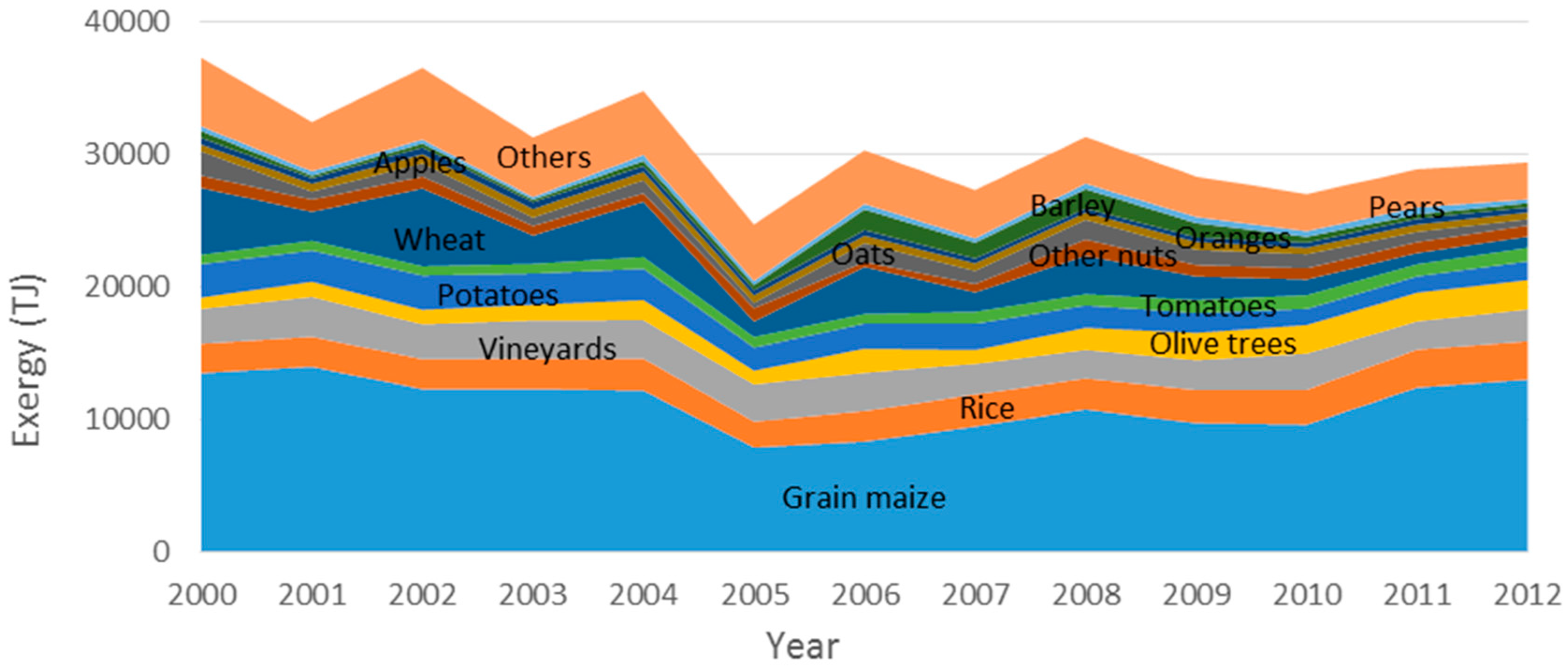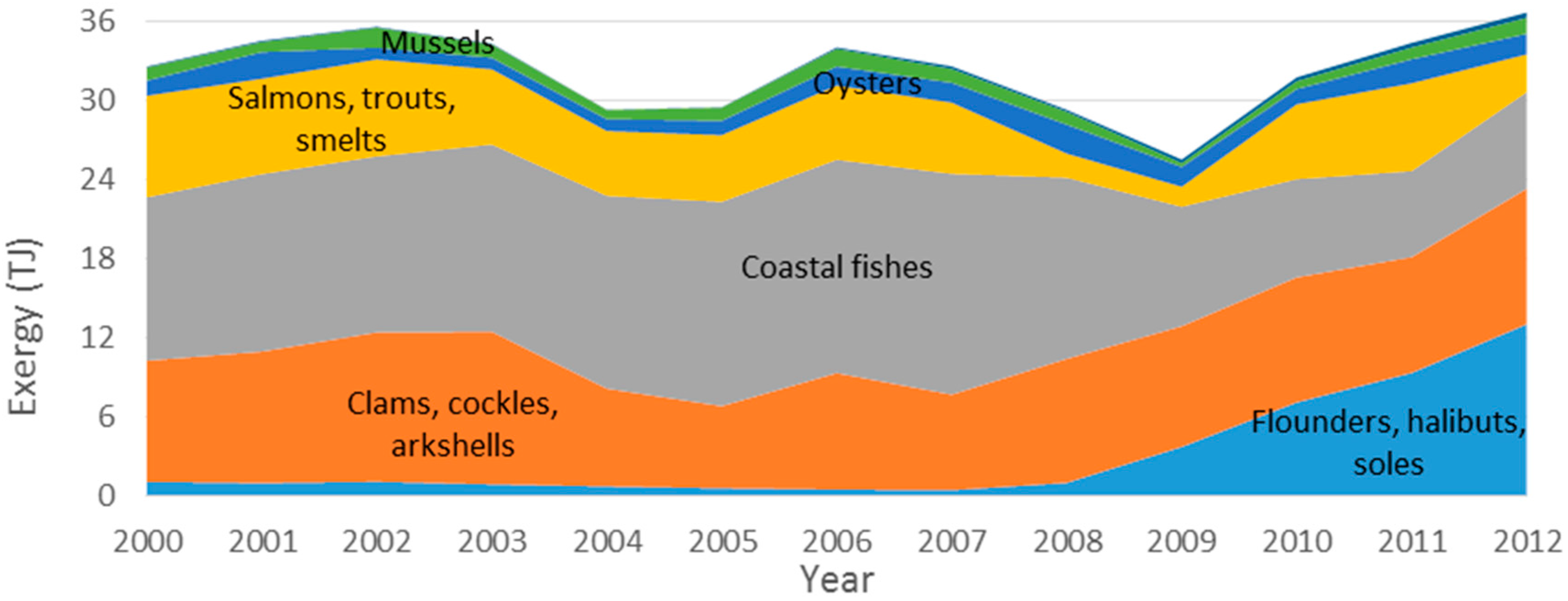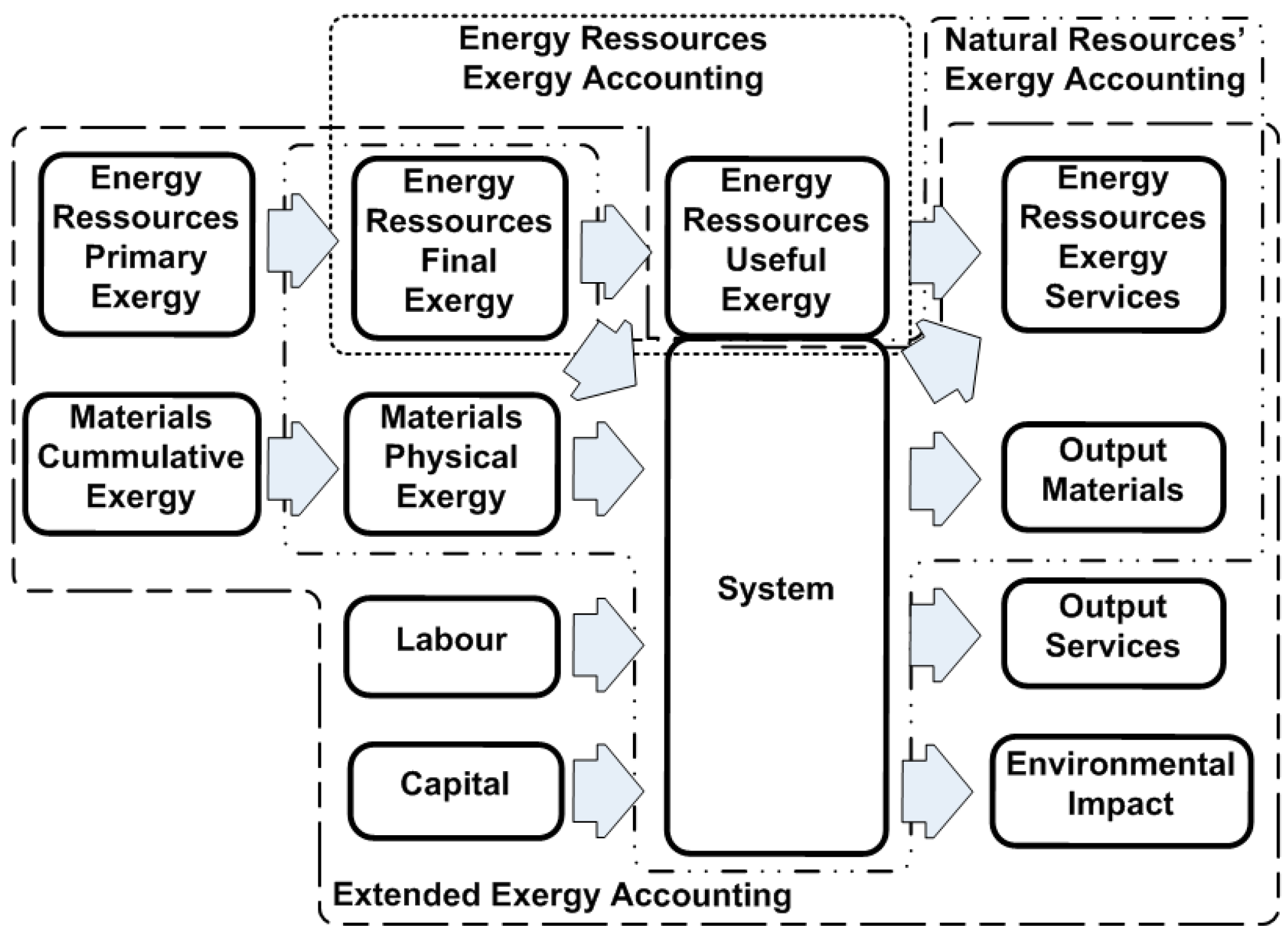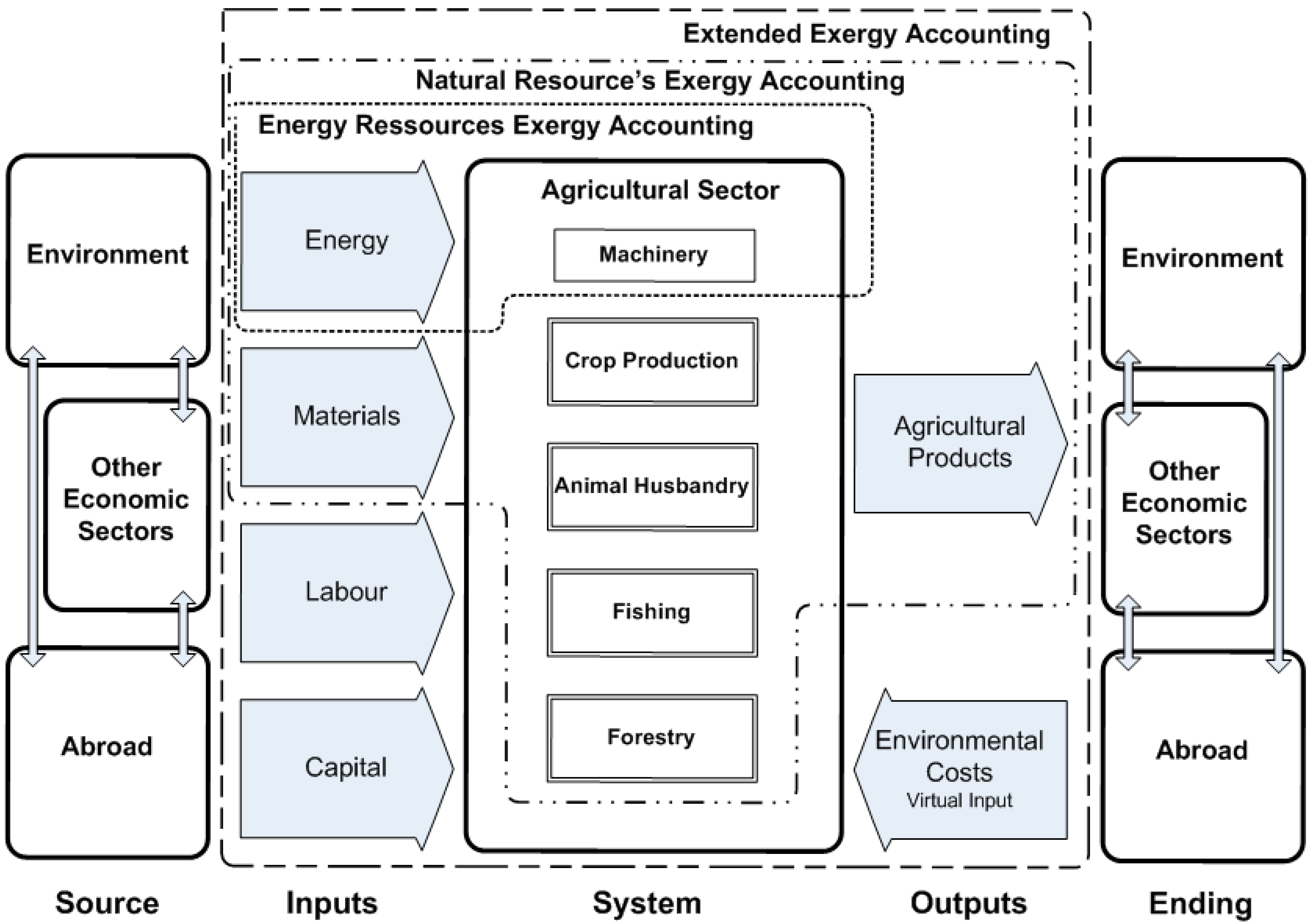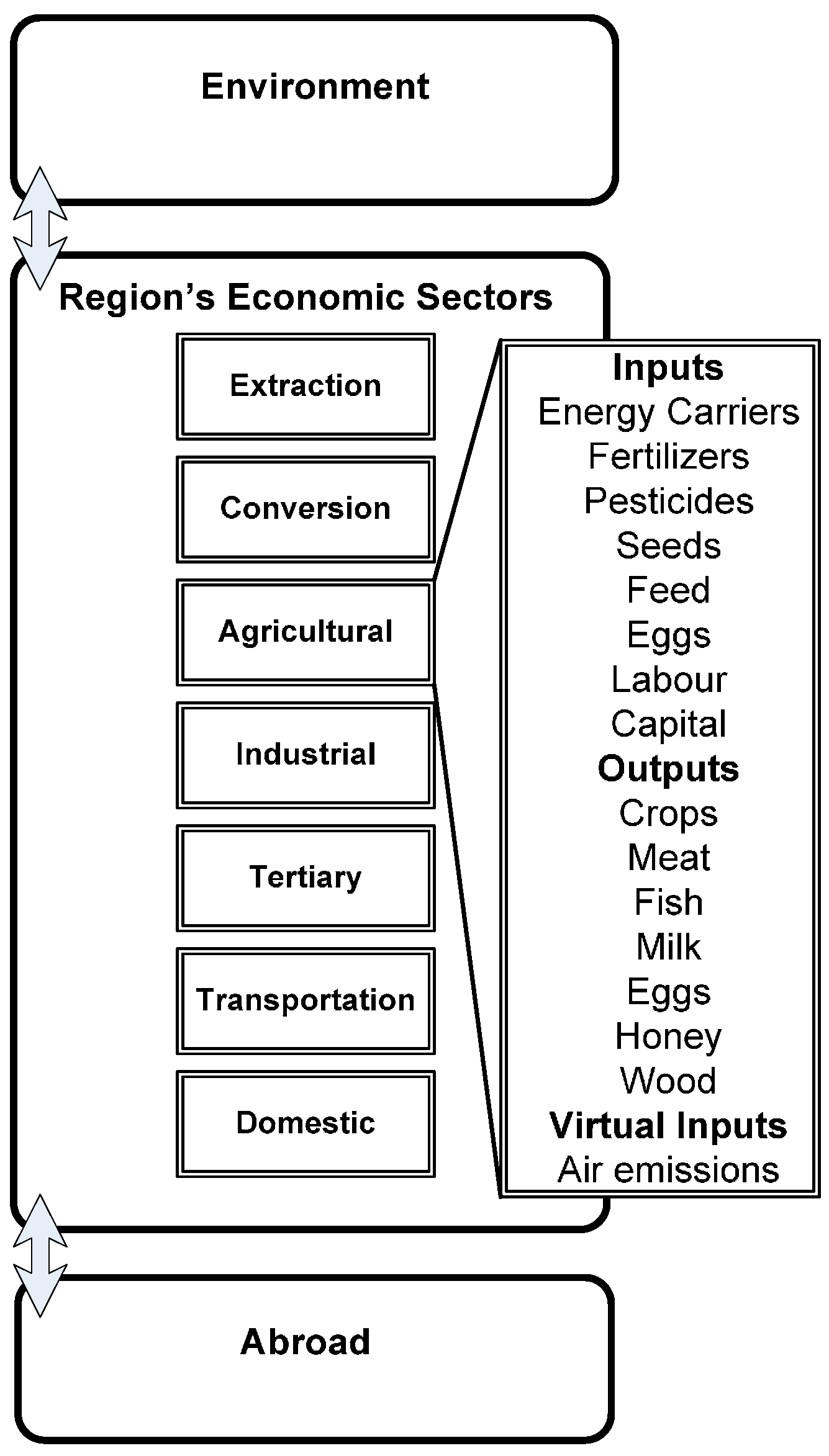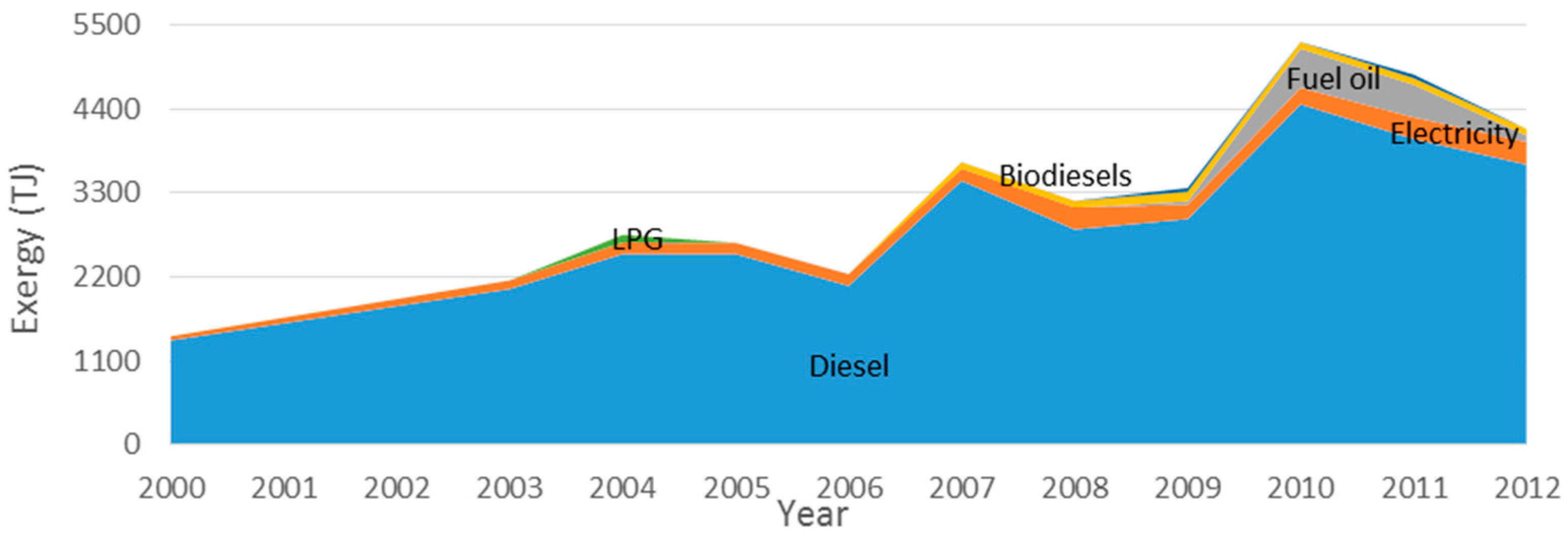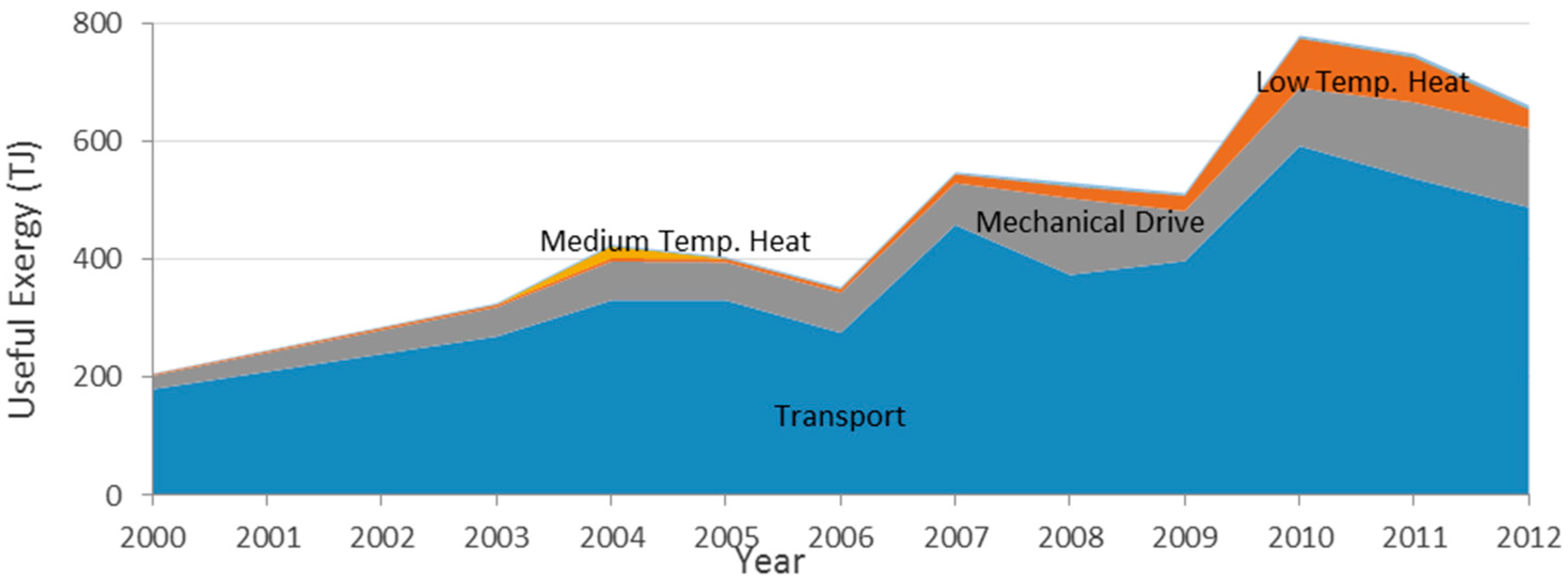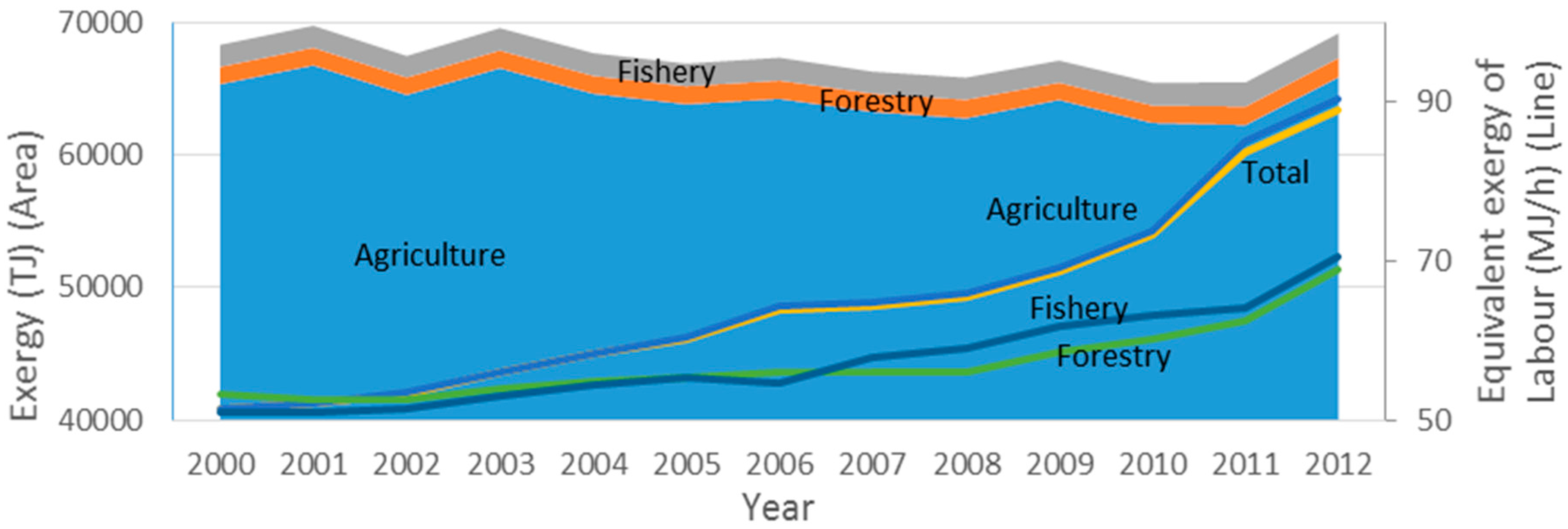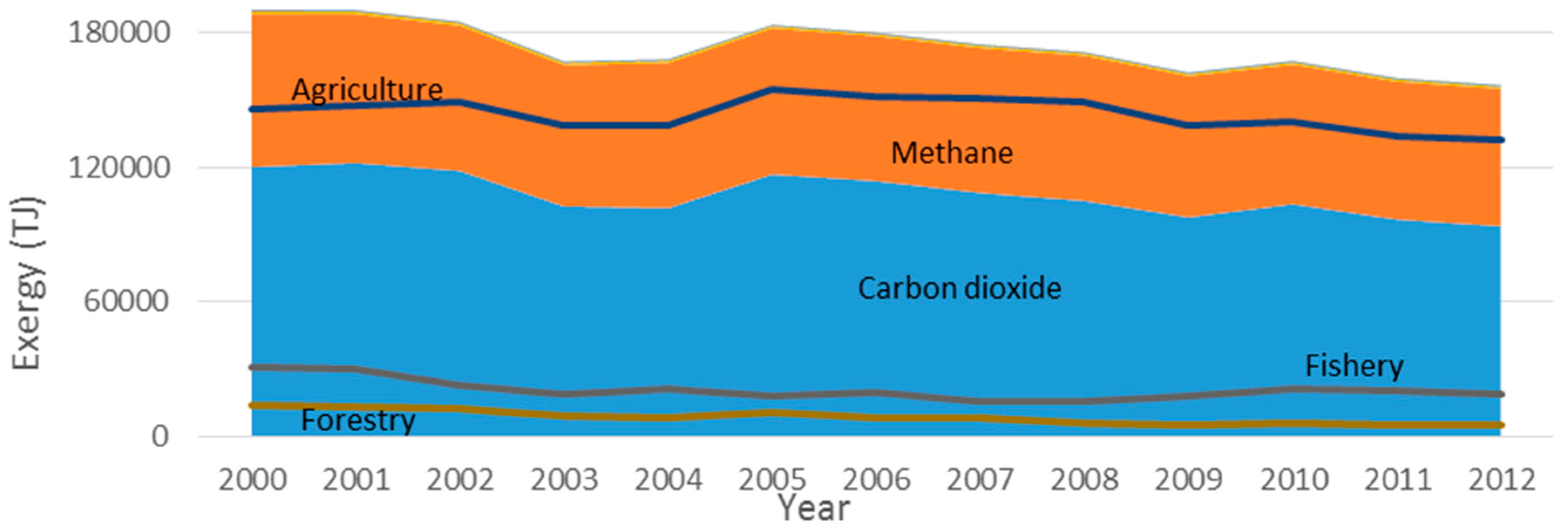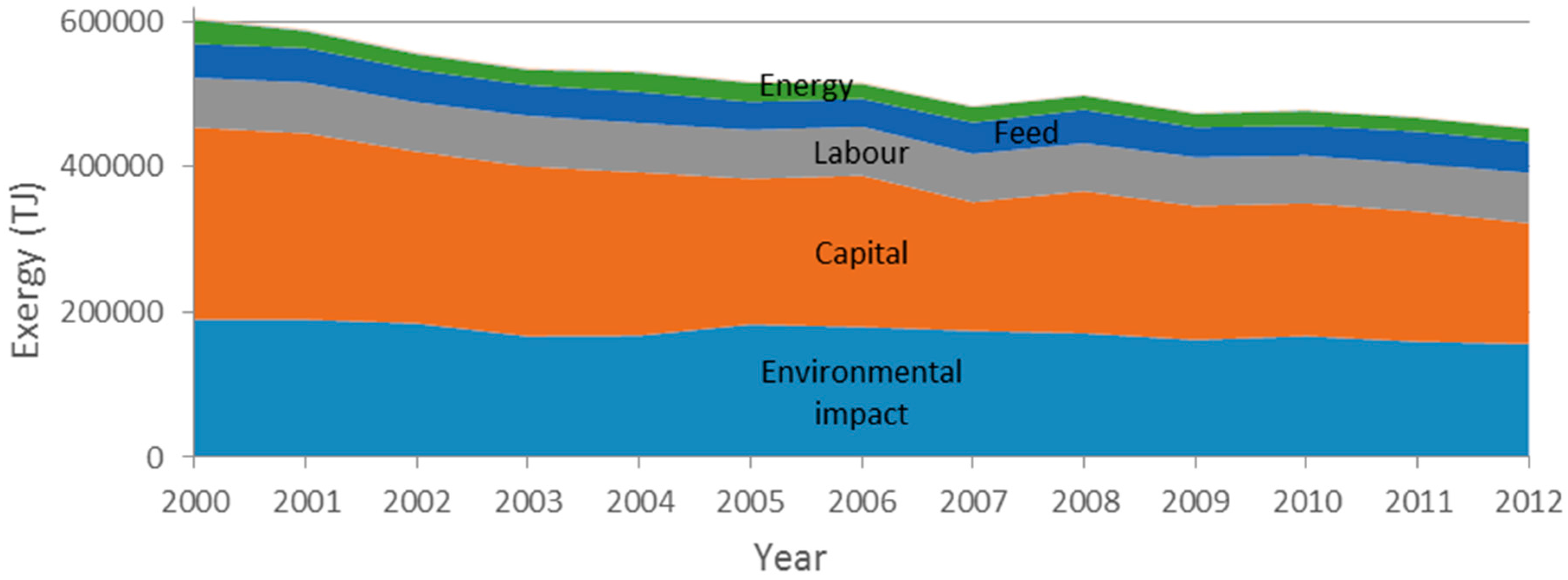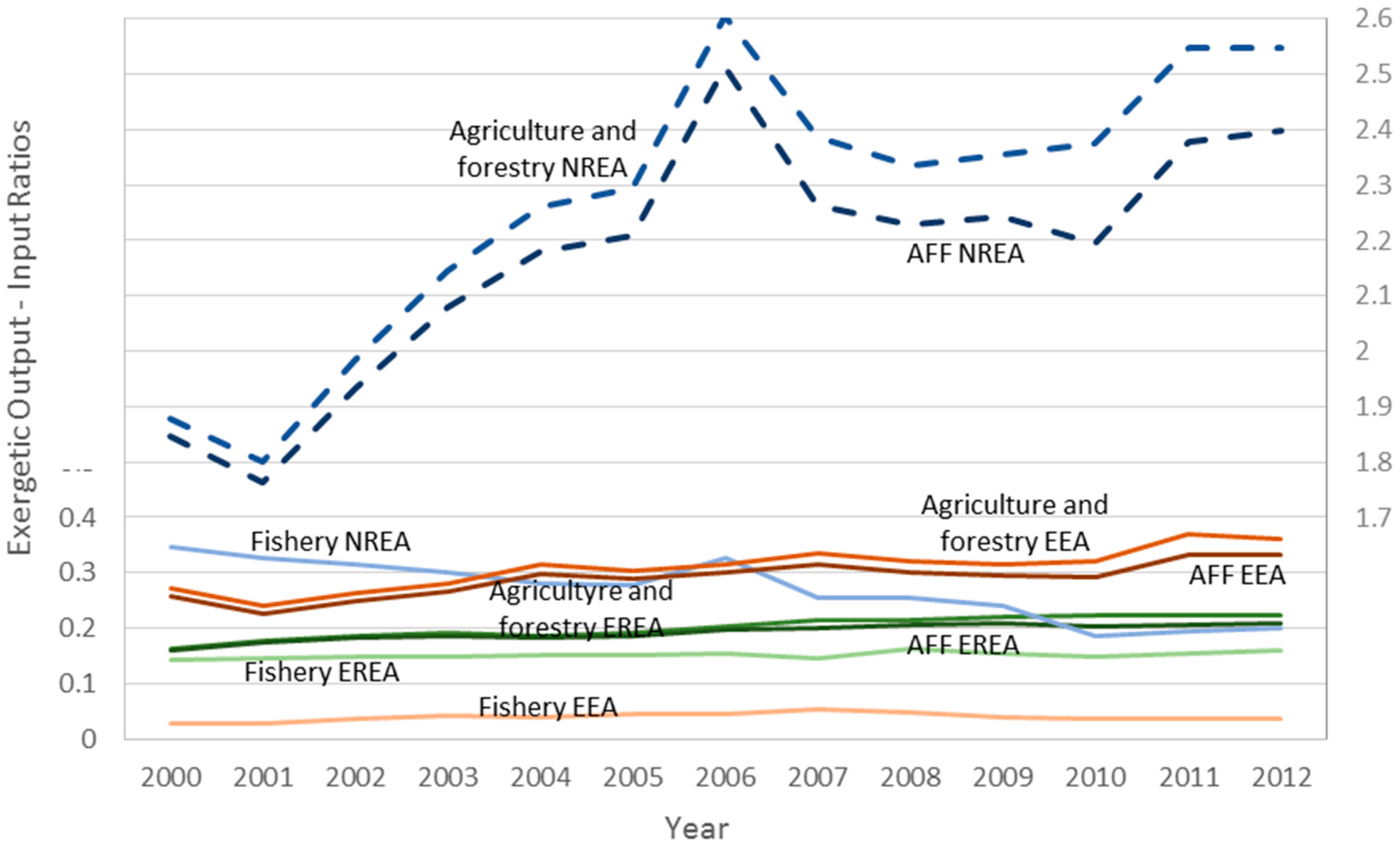1. Introduction
Sustainable development is the desirable long term goal of bringing humankind to a compromise between its welfare and the protection of our planet. According to Pezzey [
1] “A temptation when writing on ‘defining sustainability’ is to try to distill, from the myriad debates, a single definition which commands the widest possible academic consent. However, several years spent in fitful pursuit of this goal have finally persuaded me that it is an alchemist’s dream, no more likely to be found than an elixir to prolong life indefinitely”. Still, the most consensual definition of sustainable development is provided by the Brundtland Report [
2]: “Sustainable development is development that meets the needs of the present without compromising the ability of future generations to meet their own needs”.
The sustainability of society is critically dependent on the agricultural, forestry and fisheries (AFF) sector because all mass and energy flows that maintain our society come either directly from the environment or from the energy and mass surpluses obtained in this sector and the resource extraction and energy transformation sectors. The AFF sector provides all the food, feed and fiber and is also a major source of renewable energy resources. According to Committee on Twenty-First Century Systems Agriculture [
3], the sustainability of the AFF sector should take into account the environmental, social and economic dimensions:
Satisfy human food, feed, and fiber needs, and contribute to biofuels needs.
Enhance environmental quality and the resource base.
Sustain the economic viability of agriculture.
Enhance the quality of life for farmers, farm workers, and society as a whole.
Several efforts have been made in measuring the sustainability of the AFF sector, but the focus is, in most cases, only on one of the pillars of sustainability. The complementary research of both social and economic sustainability dimensions with efficiency and environmental extraction is both scarce and complex since no common unit is easily found and accepted. Also, success in one dimension does not imply the same for the others. The economic viability of an agricultural sector is not directly correlated with the environmental efficiency of the same sector nor the wellbeing of farmers.
Exergy analysis is an assessment methodology that has been used to account for efficiency at several scales, which can be society as a whole, economic sectors or industries. The term efficiency usually reflects a narrow approach that considers only one type of output and input flows. However, an efficiency measure of the AFF sector that would take into account several types of flows, such as the extraction from the environment of renewable and non-renewable resources, undesired output flows such as waste and pollution and the capital and labour flows involved, could present useful insights about its sustainability. Further assessment of other aspects, such as the economic viability of agriculture or the quality of life of farmers, would still be needed for a complete evaluation of sustainability.
Exergy is the maximum amount of work that can be obtained from a system (a resource or a flow) when it is brought to equilibrium with the surrounding environment through a reversible process [
4]. One of the key properties of exergy is that it allows the conversion of all inputs and outputs of a process into a common unit, allowing comparisons otherwise impossible.
The first methodology to quantify exergy flows was the energy resources’ exergy accounting (EREA) methodology that started with energy carriers only [
5]. Later, natural resources were included [
6] in the natural resources’ exergy accounting (NREA) methodology and more recently capital, labour and environmental externalities [
7] in the extended exergy accounting (EEA) methodology.
EREA is an input assessment method that measures the exergy embedded (or intrinsic) in the energy carriers used by the transformation devices (inputs) and the useful exergy (outputs) (
Figure 1). With EREA is possible to determine how well the system converts the final exergy to useful work from the available energy carriers and transformation devices; this knowledge can then be used to propose measurements to improve the efficiency of the system.
EREA quantifies the useful exergy that is available for each end use, but does not inform on how well that exergy service is being used. To illustrate, consider two similar gasoline vehicles on a highway, the first with only one passenger and the second with five people on board. When assessing both systems by EREA the useful exergy is the same since the energy carrier-end use pairs are the same (gasoline-transportation). However, when measuring the system output, in this case the number of passengers times distance, the performances are widely different.
NREA is an input-output assessment where all energy and matter that enters and leaves the system is accounted for (
Figure 1). Contrary to EREA, no information on how each energy carrier is used is needed but more data is required to account for all fluxes across system boundaries. By accounting both the input and output fluxes, the NREA approach measures the overall physical performance of the transformation process.
Finally, EEA is similar to NREA but also introduces capital and labour as inputs and environmental impact as a virtual input, integrating the social, economic and environmental pillars of sustainability. Translating capital, labour and environmental impact externalities into an exergetic cost is a key feature of EEA as it reflects the real thermodynamic system’s efficiency and the usually hidden resource costs [
8]. The production factors are no longer just energy resources (EREA) or energy and matter (NREA) but also immaterial flows which are essential to assess the system’s behaviour (
Figure 1). The exergy of inputs is no longer the physical and chemical exergies but the cumulative exergy introduced by [
9] in the cumulative exergy consumption methodology (CExC). The latter takes into account the sum of all the exergetic content of resources that are consumed in a production chain. Consequently, the main focus of EEA is to find the real exergy embodied into the output flows under study, adding not only all exergy necessary to bring all inputs to the specific space and time domains but also all labour, capital and environmental impacts.
First exergetic studies focusing exclusively on agriculture adopted an EREA approach and included conversion in agriculture machinery, such as tractors, and electric pumps. Agricultural sectors of Saudi Arabia [
10], Turkey [
11], Jordan [
12], Iran [
13] and finally Malaysia [
14] were studied longitudinally (except for Jordan) in order to verify the evolution of efficiency. The efficiencies of devices vary widely among studies.
First exclusive NREA approaches to agriculture also included virtual environmental impact as an input to integrate pollutant emissions [
15]. The input-output ratio was approximately 10 (ten times more exergy in inputs than outputs) but solar radiation was responsible for 90 to 95% of the inputs with an estimated photosynthetic efficiency of 4.5%. A combination of EEA and cumulative exergy extraction from the natural environment was proposed by [
16] to measure the agricultural performance of 29 countries from 1990 to 2003. As important findings, the study highlighted the three types of resources that agricultural production most extracts from the natural environment: organic content in top soil, feed and water. Finally, it concluded that the exergy efficiency in the livestock sector is much lower than in the crop sector.
Some societal exergy studies that use the EREA approach, also included, in detail, the AFF sector [
17,
18]. These studies have allocated all energy carriers (e.g., diesel) used in the AFF sector to end-uses (e.g., mechanical drive). The AFF sectors of Sweden [
19,
20], Japan [
21] and Italy [
22] were assessed by the NREA methodology where the major energetic and material inputs were considered along with all the production from the sector. EEA studies also addressed the AFF sector. Efficiencies estimated by the EEA approach for the province of Siena, Italy [
23]; the U.K. economy [
24]; Chinese society [
25,
26,
27,
28,
29], and the economy of Nova Scotia, Canada [
30] were all below 100%. These EEA studies did not take into account solar radiation, but considered crops and wood as extractions from the environment and not as productions.
All three methodologies have been used to assess the performance of society [
31] and of the AFF sector. However, analyses typically focus on results provided by only one methodology without justifying the use of that specific methodology in detriment of others. Also, there are major differences in the exergy inputs and outputs that are accounted for, across published NREA and EEA analyses of the agricultural sector. This is problematic if results provided by the three methodologies or even by the same methodology are inconsistent driving to different policy recommendations.
The present study evaluates the performance of the agricultural sector in Portugal, between 2000 and 2012, applying three exergy methodologies: the energy carrier’s exergy accounting approach, the natural resource’s exergy accounting approach and the extended exergy accounting.
4. Discussion and Conclusions
Results obtained for the Agriculture, Forestry and Fisheries (AFF) sector and subsectors, regarding the ratio of exergy outputs to inputs, using the three exergy accounting methodologies are synthesized in
Figure 21. Results for the AFF sector are similar among methodologies. With the EREA approach there is a 30% increase in the overall efficiency due to a better match between the energy carrier and the end uses. NREA presented a similar growth in overall efficiency representing the sector’s return over the applied energy and matter. The EEA methodology showed the same overall tendency regarding the evolution of efficiency, although the results are clearly dominated by the capital and environmental impact. For the fisheries subsector, the results are contradictory among methodologies.
Energy resources’ exergy accounting (EREA) only addresses one type of inputs—energy carriers—to estimate the available useful exergy for its end uses and the overall efficiency. Although it estimates the actual amount of exergy that is delivered to a system function, no information regarding the output is introduced in the analysis. For Portugal, the overall efficiency reached 21% and is rapidly increasing over time due to a bigger share of the use of electricity whose efficiency is substantially higher, mainly for its predominant use in mechanical drives, mostly associated with irrigation systems. In fisheries, diesel fuel continues to be preponderant in fishing vessels, although with lower efficiencies. This explains the different performance levels of the two subsectors.
The natural resources exergy accounting (NREA) approach uses all energetic and physical inputs and outputs to describe a system’s efficiency without any knowledge about the system’s processes and resources utilization. In the present analysis, all inputs were accounted for only by their intrinsic exergies values, not by their cumulative exergy values. The exergy that has been used to transform and bring the inputs to the boundaries of the AFF sector are integrated in the other economic sectors like industry for the fertilizers and pesticides, extraction and conversion for energy carriers and tertiary and transportation for almost all. The exergy input has decreased 24% since 2000 (
Figure 13) with feed for animal husbandry representing the biggest share (68% in 2012), followed by the energy resources. The exergy of feed is on average 140% superior to the exergy of all crops harvested, which means that Portuguese agriculture does not produce enough to support its animal husbandry. Feed does not consider green fodder, pasture, meadows and straw because these are internally produced and consumed in the sector. The output-input ratio of animal husbandry (with feed and incubation eggs as inputs, only) evolved from 26%, in 2000, to 31% in 2012. This positive evolution indicates either a better use of feed in livestock production or a bigger share of non-accounted feed. The exergy output from the sector is mostly embedded in wood and harvested crops with wood exergy reaching a share of 71% in 2012 (
Figure 11).
Although exergy is degraded, the output-input ratio of the agricultural and forestry subsectors can be higher than one (contrary to other economic sectors except extraction and conversion based on renewables) because solar radiation is not taken into account. Considering NREA, the sector’s overall ratio increased more than 27% in this period being close to 2.5 in 2012, which means that for every exergy Joule that entered in the AFF sector, two and a half Joules were harvested. Agriculture and forestry performed much better than fishery (
Figure 15) whose efficiency decreased 53% since 2000 (from 43% in 2000 to 20% in 2012). This decreasing efficiency verified for fisheries and aquaculture is exclusive for the NREA methodology. While in EREA we observe a better match between the energy carrier and the end use, in NREA the total amount of nutritional values from fish caught is decreasing for each exergy unit spent on the fishery activities.
The explanation for this puzzle is revealed by looking at the ratio of the output exergy (measured by the NREA methodology) to the useful exergy (measured by the EREA methodology) which is a proxy for the efficiency of the energy services in the AFF sector (see
Figure 22). Contrary to agriculture and forestry which improved the efficiency of the exergy services by 59% (from 27 to 47), fishery reduced theirs to 31% of the initial value (from 5 to 1.5). While in the agriculture subsector each Joule of useful exergy produced 47 Joules of food in 2012, in fishery only 1.5 Joules were caught. The agriculture and forestry subsectors are less dependent on energy resources.
The efficiency of the exergy services in fisheries is the amount of fish catch per unit of useful exergy. To explain this better, we will focus on the diesel carrier, which is responsible for almost 90% of the consumption matrix (in 2012) and used for transportation services. The fish catch per useful exergy ratio is equal to the fish catch per distance travelled times the thermodynamic efficiency of the boat engine (distance travelled per unit of useful exergy). In fisheries a higher thermodynamic efficiency is not translated into higher energy services efficiency presumably because fish population is decreasing leading fishing vessels to travel more (or more often) to get the same amount of fish.
Extended exergy accounting (EEA) allows us to compare the weight of different inputs. The exergy embodied in labour, which is less than an average daily work in other sectors (1500 h per year and per worker in 2012), has the same magnitude of all other material and energetic inputs taken together. Capital exergy is predominant over labour and although it is rapidly decreasing over time, it is larger than the overall exergy of outputs.
Figure 18 also shows that actually, the bigger input in EEA is the environmental impact from the sector, being all three immaterial inputs seven times superior to the material ones. These results raise issues regarding the proportionality between material and immaterial inputs in the EEA methodology. By considering that the cost of labour and capital is a cumulative societal exergy and, by accounting all other inputs in its intrinsic form, the study reveals the disproportionality that results from this inconsistency. Also, measuring the capital input to the sector by all currency money (M2) minus wages creates an additional problem, because some of this money is used to buy all energetic and material inputs that entered the agricultural sector, and that were taken already into account for by their intrinsic exergies. Following the proposed methodology leads to double counting all natural resources inputs because both intrinsic exergy plus the currency money necessary to buy them are taken into account.
So, are the different exergy accounting methodologies providing consistent or contradictory results? Results provided by the EREA and NREA approaches can be contradictory but they are complementary because the EREA is focused on the thermodynamic efficiency while the NREA extends the boundary allowing the evaluation of the efficiency of the energy service. Both approaches are important in providing a realistic picture of the sectorial exergy efficiency. On the other hand, results obtained by the EEA approach are completely dominated by the exergies of capital and environmental impacts, revealing the disproportionality between material and immaterial inputs in this methodology. Improving the estimation of EEA externalities, labour and capital, for sectorial studies, remains a challenge for future studies.
We propose and apply to our case studies of the AFF sector, using the NREA and EEA approaches, methodological options to account for the renewable flows obtained from the environment, that are more adequate for sustainability assessments. While former NREA and EEA studies [
19,
21,
22,
23,
24,
25,
26,
27,
28,
29,
30] account all crops, wood and fisheries as an input to the agricultural sector from the environment, this study acknowledges that all these flows are renewable and an output of human activities. Fish catch (excluding fish farming) is considered an extraction because no human activity helps to feed and raise the fish and excessive catches together with pollution have caused a decrease in fish population [
55]. For a better assessment of sustainability, it would be important to include and correctly evaluate in NREA and EEA studies, the environmental positive impact of the carbon dioxide sequestered from atmosphere by the AFF sector because, although there is a substantial fraction of the carbon content in vegetables, fruits, crops and wood that is released after consumption, some carbon remains sequestered in living beings and wood used for veneer and saw logs.
